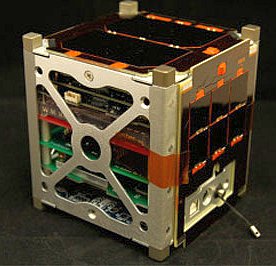
The Trailblazer mission is to prove the reliability and robustness of a Space Plug-and-play Architecture (SPA) based satellite in a space environment. Trailblazer will also show the ease of modifying current COTS parts to function on a SPA network. The satellite consists of a 1U CubeSat structure and COTS parts, modifed to be SPA compliant.
In addition to the main mission, Trailblazer will also contain a SPA-1 Dosimeter to measure the effects of the South Atlantic Anomaly and a SPA-1 rapid prototyped analog to Digital Converter (ADC) control board to test new advancements in 3D PCB design for space applications.
NASA-Catalog: ?
Beacon
437.425 MHz, 9k6 FSK, AX.25, 50 second interval, 1W
Call
Status
The launch of a Minotaur I rocket for the U.S. Air Force ORS-3 mission is scheduled to occur on November 20, 2013 from Wallops Flight Facility (WFF), Virginia, with a planned launch window from 00:30 – 02:00 UTC. The launch, from ignition to delivery of the satellites in orbit, will take a little less than twelve-and-a-half minutes, with a targeted 500 km circular orbit at an inclination of 40.5 degrees.
Mission
Trailblazer has three missions. First is to provide a proof of concept to SPA. Second is to provide flight heritage and receive radiation exposure measurements from a dosimeter designed by COSMIAC in partnership with the Air Force Research Lab. Finally, Trailblazer will be providing a space qualification platform for an exciting additive manufacturing technology designed by the University of Texas El Paso.

Space Plug-and-play Architecture SPA-1
The SPA-1 data transfer protocol is based on 400 kbit/s I2C making it the lowest power, and lowest bandwidth option for SPA. Given the power constraints of typical satellite architecture, it is generally advantageous to interface devices/modules which do not require high data transfer rates to a SPA network via the SPA-1 Applique Sensor Interface Module (ASIM). This ASIM is logic that enables SPA Plug-and-Play for hardware components. It contains all the information needed for the system to automatically discover and automatically configure the hardware component. SPA-1 ASIMs can be any microcontroller that supports I2C and has enough memory to contain the needed logic.
- manages 5 ASIMs through an 8-bit microcontroller
- allows modules to be directly integrated into another SPA bus design without modification.
- the CubeLab bus is currently being modified to allow SPA-1 devices to be tested on orbit
Completely SPA-1 based the design consists of three modules: a command and data handling system (CDH), a radio module, and a power module. Since these modules are all SPA-1 components, the satellite can be formed with a single four wire harness. Much of the satellite is empty space, and it does not do anything useful except to transmit a beacon signal, but serves to illustrate just how simple a satellite can be (if not simplistic) using a SPA methodology.